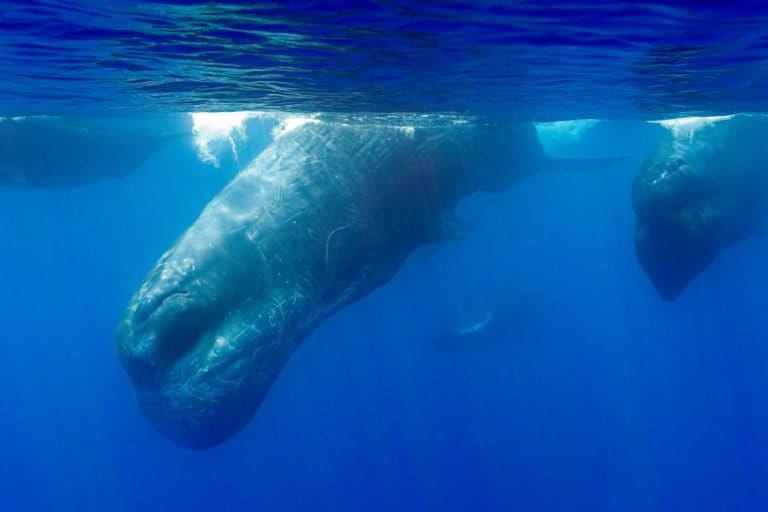- Since 2010, researchers have recorded sperm whale aggregations, or superpods, consisting of hundreds of the giant mammals in the waters off Sri Lanka from late March to early April.
- Researchers missed out on the narrow window to observe this year’s spectacle, as the COVID-19 pandemic forced a nationwide shutdown; they also failed to carry out all scheduled workshops teaching tour boat operators about responsible whale-watching.
- Restrictions in response to COVID-19 have had similar impacts in other countries as well, disrupting planned field research.
KALPITIYA, Sri Lanka — Sri Lanka is known for the blue whales (Balaenoptera musculus) that occur throughout the year in the waters around this Indian Ocean island. But a lesser-known fact is that this biodiversity hotspot is also, for a brief time of the year, a gathering spot for massive groups of sperm whales (Physeter macrocephalus), the largest toothed whale and marine predator.
Superpods, as these congregations of hundreds of sperm whales are known, have long been recorded in Sri Lankan waters, but were previously thought to be sporadic. Years of research by conservation biologist Ranil Nanayakkara of Biodiversity Education and Research (BEAR) established that these superpods are an annual event, occurring in the Gulf of Mannar on the island’s northwestern coast.
Data gathered from research expeditions since 2010 indicate the peak of the superpod season this year would have run from March 15 to April 20. But researchers missed out on observing the pod, amid a nationwide lockdown in response to the COVID-19 pandemic.

“Since 2010, every year we monitor superpods, behavior of the group, take photos for identification and record their codas using hydrophones,” Nanayakkara told Mongabay. “But due to COVID-19, we lost year 2020 superpod season, creating a void in the research.”
Nanayakkara, an expert underwater photographer, was supposed to have carried out this season’s observation with a global leader in the conservation of marine mammals, Whale and Dolphin Conservation’s ambassador Andrew Sutton, also a member of the IUCN Species Survival Commission Cetacean Specialist Group.
Sutton arrived in Sri Lanka in early March for the superpod survey, but had to rush back as COVID-19 was declared a pandemic, managing to leave the island just before flights were grounded.

Nanayakkara’s research that began in 2010 is linked to his first observation of the superpods. “We were surveying marine mammals in the ocean off Kalpitiya in the northwest of Sri Lanka,” he said. “At that time, a seasoned fisherman gave us this golden tip about a large aggregation of whales just a few nautical miles out in the deep sea. While such tips often proved to be exaggerated, we decided to have a look.
“From a distant, we noticed a blow of a whale and as we got closer, we could observe a few more,” he said. “We quickly moved closer and were stunned by what we saw: an entire group, blowing.”
His first superpod featured about 50 individuals, and he described it as spectacular. But more awaited. Nanayakkara soon began observing much larger pods of sperm whales in the same area, comprising more than 350 individuals each in 2015, 2016 and 2017.
“There were very large sperm whale aggregations in the eastern tropical Pacific, with reports of over 1,000 off Peru before whale hunting began impacting populations,” Hal Whitehead of Dalhousie University in Canada, an authority on sperm whales, told Mongabay. “I don’t know the average size of present day superpod, but an aggregation of about 350 sperm whales is a lot.
“There is very little information about this phenomenon,” he added.
Sperm whales are sociable creatures and the superpods are generally considered a mating market. Whitehead said there needs to be more research to unravel the mystery behind these spectacular gatherings.
Just as in Sri Lanka, the COVID-19 outbreak has interrupted field research around the world, stalling science. “I was due to be sailing with sperm whales off Ecuador around this time, in May, but that did not happen due to the pandemic situation,” Whitehead said.

Epic battles in the ocean
Researchers have also observed killer whales (Orcinus orca) tending to follow sperm whale superpods. These are the transient killer whales that hunt other marine mammals.
In 2017, Nanayakkara, Sutton and other researchers 0bserved an epic battle between a pod of sperm whales trying to protect females and calves from a pod of killer whales. Nanayakkara noted how the male sperm whales formed a cluster, laying side by side like logs to defend the smaller-sized females and calves from a pod of eight killer whales.
Observations of such battles between apex predators in the ocean are rare, but the superpod season makes them more likely.
“There was a possibility to witness something similar this year, too, but we have now missed the season,” Nanayakkara said.
He said he actually managed to secure a special permit to carry out ocean research during the lockdown. But a village some 45 kilometers (28 miles) from the observation base in Kalpitiya was sealed off in mid-March after the identification of a positive COVID-19 case, scuppering his plans. “I was dying to venture into the waters in search of the superpod, but it was risky to work in that region,” Nanayakkara said.

Responsible whale watching
Whale-watching is a huge part of Sri Lanka’s tourism industry, but there are concerns about boats going too close to these mammals and causing them stress.
With the support of U.K.-based Whale and Dolphin Conservation, Nanayakkara began conducting workshops for whale-watching boat operators. This year he only managed to conduct one workshop and had to cancel the others due to the lockdown.
Banner image of a male sperm whale known to researchers as Jaw-32, due to missing a part of his jaw, either caused by a deformity at birth or the result of an ocean battle. The whale is a regular member of the superpod that frequents Sri Lanka, first sighted in 2014. Image courtesy of Andrew Sutton.
